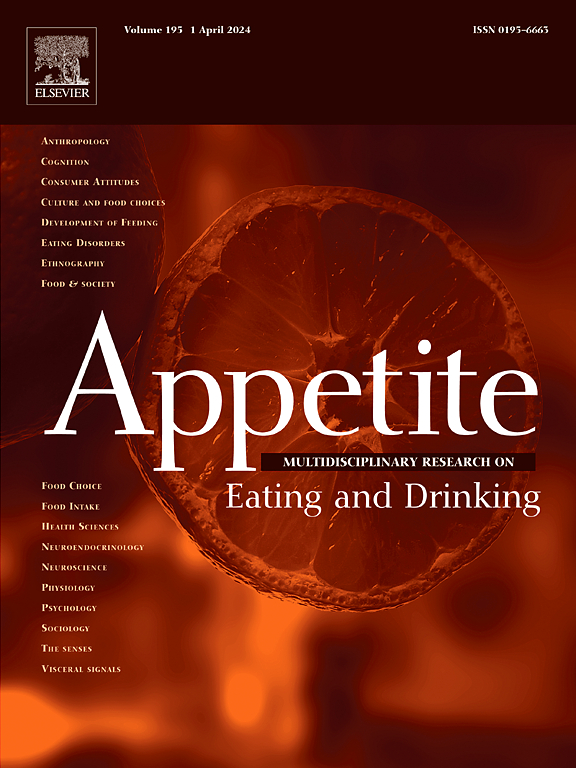与照顾者决定何时向婴儿和幼儿介绍肉类相关的因素。
IF 3.8
2区 医学
Q1 BEHAVIORAL SCIENCES
引用次数: 0
摘要
第一项食品研究确定了与照顾者决定何时给孩子介绍肉类(特别是富含铁和锌的牛肉)有关的因素。美国6-24个月大儿童的看护人完成了一项关于饮食习惯、态度和辅食引入的调查,重点是肉类引入的时间和影响因素。平均而言,护理人员在9个月左右引入肉类,比其他食物组晚。未引入肉类的母乳喂养时间(平均=10.0个月,SE=0.5)比引入肉类的母乳喂养时间(平均=8.6个月,SE=0.3, p=0.026)更长。护理人员根据引入牛肉的时间分为两组:早期(4-6个月,n=52),大部分(7-11个月,n=151)和晚期(10 - 12个月,n=85)。方差分析和卡方检验确定了组间差异,并通过反向消除的多项回归确定了牛肉引入时间的预测因子。与多数组相比,那些更喜欢食物(p=0.002)、更挑食(p=0.024)、照顾者更经常吃肉(p=0.010)的孩子更有可能成为“早期组”的一员。年龄较大的照顾者的孩子进入“晚”组的几率更大(p=0.001),他们对肉的整体依恋程度较弱(p=0.012),根据熟悉程度选择食物(p=0.017),并在喂养孩子时将食物作为奖励(p=0.041)。推迟肉类和牛肉的引入引发了对儿童饮食营养充足性的质疑,特别是对那些母乳喂养的儿童。了解能够预测护理人员决定何时引入肉类的因素,有助于制定确保幼儿营养充足的策略。本文章由计算机程序翻译,如有差异,请以英文原文为准。
Factors associated with caregivers’ decisions about when to introduce meat to their infants and toddlers
The 1st Foods Study identified factors associated with caregivers' decisions about when to introduce meat, specifically beef, a food rich in iron and zinc, to their children. Caregivers of 6–24-month-old children across the U.S. completed a survey on dietary habits, attitudes, and complementary food introduction, with a focus on the timing of meat introduction and the factors that influenced it. On average, caregivers introduced meat at ∼9 months, later than other food groups. Those who had not introduced meat breastfed longer (Mean = 10.0 mo, SE = 0.5) than those who had (Mean = 8.6 mo, SE = 0.3, p = 0.026). Caregivers were divided into groups based on the timing of beef introduction: Early (4–6 months, n = 52), Majority (7–11 months, n = 151), and Late (≥12 months, n = 85). Analyses of variance and chi-square tests identified group differences, and a multinomial regression with backward elimination identified predictors of the timing of beef introduction. Relative to the Majority group, children who enjoyed food more (p = 0.002), were fussier eaters (p = 0.024), and had a caregiver who ate meat more frequently (p = 0.010) had a greater odds of being in the Early group. The odds of being in the Late group were greater for children with older caregivers (p = 0.001), who had a weaker overall attachment to meat (p = 0.012), chose food based on familiarity (p = 0.017), and used food as a reward when feeding their child (p = 0.041). Delaying meat and beef introduction raises questions about the nutritional adequacy of children's diets, especially for those who are breastfed. Understanding factors that predict caregivers' decisions about when to introduce meat can aid in developing strategies to ensure adequate nutrition for young children.
求助全文
通过发布文献求助,成功后即可免费获取论文全文。
去求助
来源期刊

Appetite
医学-行为科学
CiteScore
9.10
自引率
11.10%
发文量
566
审稿时长
13.4 weeks
期刊介绍:
Appetite is an international research journal specializing in cultural, social, psychological, sensory and physiological influences on the selection and intake of foods and drinks. It covers normal and disordered eating and drinking and welcomes studies of both human and non-human animal behaviour toward food. Appetite publishes research reports, reviews and commentaries. Thematic special issues appear regularly. From time to time the journal carries abstracts from professional meetings. Submissions to Appetite are expected to be based primarily on observations directly related to the selection and intake of foods and drinks; papers that are primarily focused on topics such as nutrition or obesity will not be considered unless they specifically make a novel scientific contribution to the understanding of appetite in line with the journal's aims and scope.
 求助内容:
求助内容: 应助结果提醒方式:
应助结果提醒方式:


